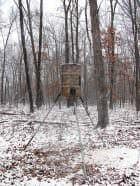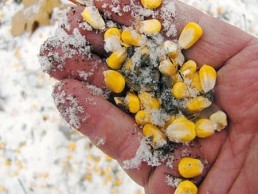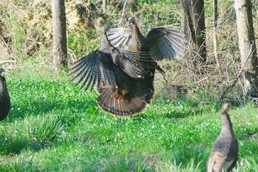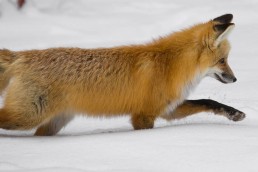Supplementary Feeding Helps Winter Wild Turkeys
SHARE THIS POST
I hear both the pros and cons of feeding turkeys during winter months. I’m all for supplementary feeding winter flocks if the right program is put in place, dependent of conditions, type of terrain and area of the country.
I’ve hosted outdoor media hunts for years in northern Missouri to pull turkeys in from throughout the area, and have had a healthy flock. During late January and February we designed a feeding program just for that area.
During late winter, after food plots and crop fields were completely wiped out from high densities of feeding deer, heavy snow, ice storms and brutal cold, feeding not only helped turkeys, but all wildlife, including deer, pheasants and quail.
My program consisted of a dozen tripod-type barrels spread out on 1,200 acres that would disperse-feed twice a day, and a 55-gallon broadcast-type spreader that attaches to my truck trailer hitch. Whole corn works best; cracked corn is not good because of mold. Soybeans are also a good high-energy supplementary food source.

The key to my program to prevent poaching and disease from barrel feeders is, one, always set up feeders in remote wooded areas away from roads, and two, move each feeder three to four times a month, depending on the turkey’s use.
Are you enjoying this post?
You can be among the first to get the latest info on where to go, what to use and how to use it!
Moving a feeder 100 yards or so in the same area prevented dropping buildup underneath the feeder, which can cause disease and predator problems.
During extreme conditions, including ice, with no acorns and with crop fields and food plots wiped out, broadcasting using a truck worked extremely well. I really like this method, driving the edge of crop fields and spreading corn in edge cover—turkeys have to work for it. During some very extreme conditions, spreading corn on the edges of a cornfield and directly on soybeans on a field worked extremely well, as both are areas turkeys were used to feeding.
In the Ozarks—in timber where there are no crop fields or food plots—I feel it’s even more important to feed, especially during years of no acorn production. I also move feeders and use a spreader on remote ridge top logging roads. The result is not only a healthy flock, but also lots of spring gobblers, even after break-up, because of the holding so many hens in our area.
Ray Eye is a MidWest Outdoors hunting instructor. He was raised in the turkey-rich hills of the Missouri Ozarks, and is considered the dean of America’s professional turkey hunters. It’s less widely known that he is an expert hunter for many other species. Eye has produced an online course, “Calling is Everything,” that details how to call turkeys at any season of the year. Find it at eyesontheoutdoors.com.
MWO
SHARE THIS POST
Did you enjoy this post?
You can be among the first to get the latest info on where to go, what to use and how to use it!
Ray Eye
Ray Eye is an award-winning outdoor communications giant. Eye has a huge following with writing, radio, television and national seminars. This Missouri native is a Missouri Conservation Communicator of the Year, NWTF national Communicator of the Year and was inducted into the “Legends of the Outdoors” National Hall of Fame.



